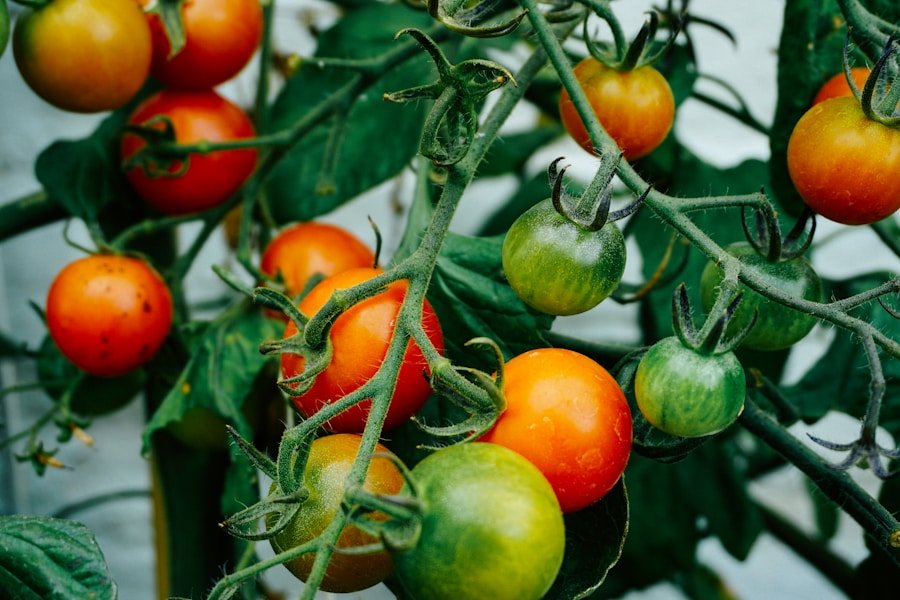Hydroponic tomato cultivation is a soilless method of growing tomatoes, where nutrient-rich water serves as the growing medium. This approach enables growers to exert greater control over the growing environment, resulting in accelerated growth rates and increased yields. By providing plants with precise amounts of essential nutrients, hydroponic systems can produce tomatoes that are more flavorful and nutritious than those grown using traditional soil-based methods.
Furthermore, hydroponic systems are water- and space-efficient, making them an attractive option for home gardeners with limited resources. A fundamental principle of hydroponic tomato cultivation is the use of a nutrient solution to supply plants with essential minerals and nutrients. This solution typically consists of water and a customized blend of fertilizers tailored to the specific needs of tomato plants.
By closely monitoring and adjusting the nutrient solution, growers can ensure that their tomatoes receive optimal levels of nutrients throughout the growing process. This level of precision is a key advantage of hydroponic cultivation, as it allows for better control over plant health and growth.
Key Takeaways
- Hydroponic tomato cultivation allows for growing tomatoes without soil, using nutrient-rich water solutions.
- The right hydroponic system for tomatoes depends on factors such as space, budget, and personal preference.
- Certain tomato varieties are better suited for hydroponic growth, such as cherry tomatoes or determinate varieties.
- The growing medium and nutrient solution for hydroponic tomatoes should provide essential nutrients and support root growth.
- Proper care for hydroponic tomato seedlings includes monitoring water levels, pH balance, and managing pests and diseases.
Choosing the Right Hydroponic System for Tomatoes
Understanding Nutrient Film Technique (NFT)
One popular choice is the nutrient film technique (NFT), which involves growing plants in a shallow stream of nutrient-rich water. This method is ideal for tomatoes, as it provides them with a constant supply of water and nutrients while allowing their roots to access oxygen.
Exploring Drip Systems and Aeroponics
Another option is the drip system, which delivers nutrient solution directly to the base of each plant through a network of tubes and emitters. This method is efficient and easy to set up, making it a good choice for beginners. For those looking for a more advanced option, aeroponic systems offer a high level of control over plant growth. In these systems, plants are suspended in the air and their roots are misted with nutrient solution at regular intervals.
Factors to Consider When Choosing a Hydroponic System
Whichever system you choose, it’s important to consider factors such as space, budget, and level of expertise when making your decision. By taking these factors into account, you can ensure that you select a hydroponic system that meets your needs and helps you achieve optimal tomato growth.
Selecting the Best Tomato Varieties for Hydroponic Growth
When it comes to selecting tomato varieties for hydroponic cultivation, there are several factors to consider. One important consideration is the size of the plant, as some varieties are better suited to the confined space of a hydroponic system than others. Determinate varieties, which grow to a predetermined size and produce fruit all at once, are often a good choice for hydroponic cultivation.
Indeterminate varieties, on the other hand, continue to grow and produce fruit throughout the season, making them more challenging to manage in a limited space. Another important factor to consider is the type of fruit produced by the variety. Some tomatoes are best suited for slicing and eating fresh, while others are better for canning or making sauces.
Additionally, some varieties are more resistant to common pests and diseases, making them a good choice for hydroponic cultivation. By carefully considering these factors, growers can select tomato varieties that are well-suited to their specific needs and growing conditions.
Preparing the Growing Medium and Nutrient Solution
| Stage | Duration | Temperature | Humidity |
|---|---|---|---|
| Seedling | 1-2 weeks | 70-75°F | 60-70% |
| Vegetative | 3-4 weeks | 75-85°F | 40-60% |
| Flowering | 6-8 weeks | 65-75°F | 40-50% |
| Fruit Development | 6-8 weeks | 70-80°F | 40-50% |
Before planting hydroponic tomato seedlings, it’s important to prepare the growing medium and nutrient solution that will support their growth. The growing medium used in hydroponic systems can vary depending on the specific system and grower preferences. Some common options include rockwool, perlite, vermiculite, and coconut coir.
These materials provide support for the plants’ roots while allowing for good drainage and oxygenation. When preparing the growing medium, it’s important to ensure that it is clean and free from any contaminants that could harm the plants. In addition to the growing medium, growers will also need to prepare a nutrient solution that provides essential minerals and nutrients to the tomato plants.
This solution typically includes a mix of fertilizers that are tailored to the specific needs of tomatoes, including nitrogen, phosphorus, potassium, calcium, magnesium, and trace elements such as iron and zinc. By carefully measuring and mixing these components, growers can create a nutrient solution that provides everything their tomato plants need to thrive. It’s important to regularly monitor and adjust the nutrient solution throughout the growing process to ensure that the plants receive the optimal levels of nutrients.
Planting and Caring for Hydroponic Tomato Seedlings
Once the growing medium and nutrient solution are prepared, it’s time to plant hydroponic tomato seedlings. When planting seedlings in a hydroponic system, it’s important to handle them carefully to avoid damaging their delicate roots. The seedlings should be placed in the growing medium at a depth that allows their roots to be fully covered while leaving their stems and leaves exposed to light.
After planting, it’s important to provide the seedlings with adequate light, warmth, and humidity to support their growth. As the tomato plants grow, it’s important to monitor their progress and make any necessary adjustments to their growing environment. This may include adjusting the nutrient solution, providing additional support for the plants as they grow taller, and pruning away any damaged or diseased foliage.
Additionally, it’s important to regularly check for signs of pests or diseases and take appropriate measures to control them. By providing attentive care throughout the growing process, growers can ensure that their hydroponic tomato plants reach their full potential.
Managing Pests and Diseases in Hydroponic Tomato Cultivation
Managing Pests and Diseases in Hydroponic Tomato Cultivation Pests and diseases are a significant threat to hydroponic tomato cultivation, affecting plant health and yield. Common pests that can affect tomatoes include aphids, whiteflies, spider mites, and thrips, while diseases such as powdery mildew, blight, and bacterial spot can also pose significant threats.
Proactive Measures for Pest and Disease Management
To manage these issues in a hydroponic system, it’s essential to take proactive measures such as regularly inspecting plants for signs of pests or diseases and taking appropriate action at the first sign of trouble.
Methods for Controlling Pests and Diseases
Several methods can be used to control pests and diseases in hydroponic tomato cultivation. One option is to use biological controls such as predatory insects or beneficial microorganisms that can help keep pest populations in check. Additionally, physical barriers such as insect netting or sticky traps can be used to prevent pests from reaching the plants.
Preventing Disease Spread through Good Hygiene Practices
When it comes to diseases, maintaining good hygiene practices such as regularly cleaning equipment and removing any infected plant material can help prevent their spread. By taking a proactive approach to pest and disease management, growers can minimize their impact on hydroponic tomato plants.
Harvesting and Enjoying Homegrown Hydroponic Tomatoes
After months of careful cultivation, it’s finally time to harvest homegrown hydroponic tomatoes. When harvesting tomatoes, it’s important to pick them at the peak of ripeness for the best flavor and texture. This typically means waiting until the fruits have fully developed their color and are slightly soft to the touch.
By gently twisting or cutting the fruits from the plant at this stage, growers can ensure that they are at their best when enjoyed fresh or used in cooking. Once harvested, homegrown hydroponic tomatoes can be enjoyed in a variety of ways. Whether eaten fresh in salads or sandwiches, cooked into sauces or soups, or preserved through canning or freezing, homegrown tomatoes offer a level of flavor and freshness that is hard to beat.
Additionally, by saving seeds from the best fruits each year, growers can continue to cultivate their favorite varieties in future seasons. By savoring the fruits of their labor and sharing them with friends and family, growers can fully appreciate the rewards of homegrown hydroponic tomatoes. In conclusion, growing hydroponic tomatoes at home offers an exciting opportunity for gardeners to experience the benefits of this innovative cultivation method.
By understanding the principles of hydroponic cultivation, choosing the right system and varieties, preparing the growing medium and nutrient solution, planting and caring for seedlings, managing pests and diseases, and finally harvesting and enjoying homegrown tomatoes, growers can experience the satisfaction of producing flavorful and nutritious fruits in their own homes. With careful attention to detail and a passion for plant care, anyone can enjoy success in growing hydroponic tomatoes at home.
FAQs
What is hydroponic gardening?
Hydroponic gardening is a method of growing plants without soil, using a nutrient-rich water solution to deliver essential nutrients directly to the plant’s roots.
Why grow tomatoes hydroponically?
Growing tomatoes hydroponically can result in faster growth, higher yields, and better control over the plant’s environment, leading to healthier and more flavorful tomatoes.
What are the basic steps to grow hydroponic tomatoes at home?
The basic steps to grow hydroponic tomatoes at home include selecting a suitable hydroponic system, choosing the right tomato variety, starting seeds, transplanting seedlings, maintaining the nutrient solution, and providing proper lighting and support for the plants.
What are the advantages of growing hydroponic tomatoes?
Advantages of growing hydroponic tomatoes include water conservation, space efficiency, reduced risk of soil-borne diseases, and the ability to grow tomatoes year-round regardless of outdoor weather conditions.
What are the key factors to consider when growing hydroponic tomatoes?
Key factors to consider when growing hydroponic tomatoes include maintaining proper pH and nutrient levels in the water, providing adequate lighting, ensuring good air circulation, and supporting the plants as they grow and produce fruit.
What are some common challenges when growing hydroponic tomatoes?
Common challenges when growing hydroponic tomatoes include nutrient imbalances, temperature fluctuations, pest infestations, and the need for regular monitoring and maintenance of the hydroponic system.






